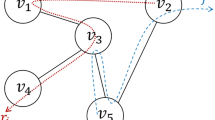Abstract
We consider the problem of exploring an anonymous undirected graph using an oblivious robot. The studied exploration strategies are designed so that the next edge in the robot’s walk is chosen using only local information, and so that some local equity (fairness) criterion is satisfied for the adjacent undirected edges. Such strategies can be seen as an attempt to derandomize random walks, and are natural counterparts for undirected graphs of the rotor-router model for symmetric directed graphs. The first of the studied strategies, known as Oldest-First, always chooses the neighboring edge for which the most time has elapsed since its last traversal. Unlike in the case of symmetric directed graphs, we show that such a strategy in some cases leads to exponential cover time. We then consider another strategy called Least-Used-First which always uses adjacent edges which have been traversed the smallest number of times. We show that any Least-Used-First exploration covers a graph G = (V, E) of diameter D within time O(D|E|), and in the long run traverses all edges of G with the same frequency.
Similar content being viewed by others
References
Aldous, D., Fill, J.: Reversible Markov chains and random walks on graphs. http://stat-www.berkeley.edu/users/aldous/RWG/book.html (2001)
Aleliunas, R., Karp, R.M., Lipton R.J., Lovász, L., Rackoff, C.: Random walks, universal sequences and the complexity of maze problems. In: Proceedings of 20th Annual IEEE Symposium on the Foundations of Computer Science (FOCS’79), pp. 218–223 (1979)
Ambühl C., Gasieniec L., Pelc A., Radzik T., Zhang X.: Tree exploration with logarithmic memory. ACM Trans. Algorithms 7(2), 17 (2011)
Bampas, E., Gasieniec, L., Hanusse, N., Ilcinkas, D., Klasing, R., Kosowski, A.: Euler tour lock-in problem in the rotor-router model. In: Proceedings of 23rd International Symposium on Distributed Computing (DISC’09), LNCS 5805, pp. 423–435 (2009)
Bampas, E., Gasieniec, L., Klasing, R., Kosowski, A., Radzik, T.: Robustness of the rotor-router mechanism. In: Proceedings of 13th International Conference on Principles of Distributed Systems (OPODIS’09), LNCS 5923, pp. 345–358 (2009)
Bender M.A., Fernández A., Ron D., Sahai A., Vadhan S.P.: The power of a pebble: exploring and mapping directed graphs. Inf. Comput. 176(1), 1–21 (2002)
Bhatt S.N., Even S., Greenberg D.S., Tayar R.: Traversing directed eulerian mazes. J. Graph Algorithms Appl. 6(2), 157–173 (2002)
Cooper J., Doerr B., Friedrich T., Spencer J.: Deterministic random walks on regular trees. Random Struct. Algorithms 37(3), 353–366 (2010)
Deng X., Papadimitriou C.H.: Exploring an unknown graph. J. Graph Theory 32(3), 265–297 (1999)
Ding, J., Lee, J.R., Peres, Y.: Cover times, blanket times, and majorizing measures. In: Proceedings of 43rd ACM Symposium on Theory of Computing (STOC’11), pp. 61–70 (2011)
Doerr B., Friedrich T.: Deterministic random walks on the two-dimensional grid. Comb. Probab. Comput. 18, 123–144 (2009)
Fraigniaud P., Ilcinkas D., Peer G., Pelc A., Peleg D.: Graph exploration by a finite automaton. Theor. Comput. Sci. 345(2–3), 331–344 (2005)
Friedrich, T., Sauerwald, T.: The cover time of deterministic random Walks. In: Proceedings of 16th Annual International Conference on Computing and Combinatorics (COCOON’10), LNCS 6196, pp. 130–139 (2010)
Hemmerling, A.: Labyrinth problems: Labyrinth-searching abilities of automata. Teubner-Texte zur Mathematik, vol. 114 (1989)
Ikeda S., Kubo I., Yamashita M.: The hitting and cover times of random walks on finite graphs using local degree information. Theor. Comput. Sci. 410(1), 94–100 (2009)
Kahn, J., Kim, J.H., Lovász, L., Vu, V.H.: The cover time, the blanket time, and the Matthews bound. In: Proceedings of 41st Annual Symposium on Foundations of Computer Science (FOCS’00), IEEE, pp. 467–475 (2000)
Koenig, S.: Complexity of edge counting. In: Goal-Directed Acting with Incomplete Information. Technical Report CMU-CS-97-199, Carnegie Mellon University (1997)
Koenig, S., Simmons, R.G.: Easy and hard testbeds for real-time search algorithms. In: Proceedings of National Conference on Artificial Intelligence, pp. 279–285 (1996)
Koucký M.: Universal traversal sequences with backtracking. J. Comput. Syst. Sci. 65(4), 717–726 (2002)
Lovász L.: Random walks on graphs: a survey. Bolyai Soc. Math. Stud. 2, 353–397 (1996) Budapest
Malpani N., Chen Y., Vaidya N.H., Welch J.L.: Distributed token circulation in mobile ad hoc networks. IEEE Trans. Mobile Comput. 4(2), 154–165 (2005)
Reingold, O.: Undirected ST-connectivity in log-space. In: Proceedings of 37th Annual ACM Symposium on Theory of Computing (STOC’05), pp. 376–385 (2005)
Saks, M.E.: Randomization and derandomization in space-bounded computation. In: Proceedings of 11th Annual IEEE Conference on Computational Complexity, pp. 128–149 (1996)
Wagner, I.A., Lindenbaum, M., Bruckstein, A.M.: Smell as a computational resource—a lesson we can learn from the ants. In: Proceedings of Fourth Israeli Symposium on Theory of Computing and Systems (ISTCS’96), pp. 219–230 (1996)
Wagner I.A., Lindenbaum M., Bruckstein A.M.: Distributed covering by ant-robots using evaporating traces. IEEE Trans. Robot. Autom. 15(5), 918–933 (1999)
Winkler P., Zuckerman D.: Multiple cover time. Random Struct. Algorithms 9(4), 403–411 (1996)
Yanovski V., Wagner I.A., Bruckstein A.M.: A distributed ant algorithm for efficiently patrolling a network. Algorithmica 37(3), 165–186 (2003)
Author information
Authors and Affiliations
Corresponding author
Additional information
The research was partially supported by the ANR project “ALADDIN”, the INRIA équipe-project “CEPAGE”, and the Royal Society IJP grant “Random walks, interacting particles and faster network exploration”.
A. Kosowski was partially supported by Polish Ministry Grant N206 491738.
Rights and permissions
About this article
Cite this article
Cooper, C., Ilcinkas, D., Klasing, R. et al. Derandomizing random walks in undirected graphs using locally fair exploration strategies. Distrib. Comput. 24, 91–99 (2011). https://doi.org/10.1007/s00446-011-0138-4
Received:
Accepted:
Published:
Issue Date:
DOI: https://doi.org/10.1007/s00446-011-0138-4




